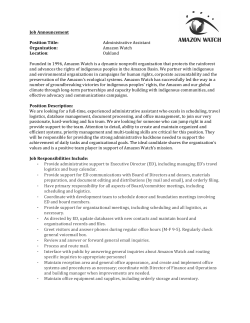
Surface Freshwater Extent and Storage Variability at Basin-to
Surface Freshwater Extent and Storage Variability at Basin-to-Global Scale from Multi-Satellite Observations Fabrice PAPA, Catherine Prigent, Filipe Aires, and Frederic Frappart fabrice.papa@ird.fr catherine.prigent@obspm.fr The continental water cycle Basin-scale water balance equation dW/dt = P - E - Q Total Water Storage Precipitation Evapotransp. Discharge = Surface water ? Large uncertainties Limited in situ observations Soil Moisture ? Ground Water ?? Individual contribution to the total storage, their variability, and their interactions poorly known Surface waters from space Today, no satellite mission specifically dedicated to the evaluation of the surface waters, but complementary satellite missions can help better characterize and understand surface water dynamics at global scale: Surface water Surface water extent and its dynamics: Global Inundation Extent from Multi-Satellites (GIEMS) The variations of the surface water storage: Example of the Amazon basin Surface water extent and its dynamics Visible and infrared (e.g. AVHRR, MODIS) • high spatial resolutions • unable to penetrate vegetation and clouds • very useful in semi-arid environments Ex: the Niger inner delta, Crétaux et al., 2014 Active microwave (SAR) • very high spatial resolution • large data volume: difficult to handle for global analysis • few time samples so far: difficult to assess the dynamic Ex: the Mekong delta, Kuenzer et al., 2013 Passive microwave (e.g., SSM/I, AMSR) • water reduces emissivities in both linear polarizations • difficult to account for vegetation contribution when used alone • low spatial resolution (~ 20 km) Ex: the Amazon, Sippel et al., 1998 Dynamics of surface water extent at global scale from multi-satellites Development of a multi-satellite technique that quantifies the monthly extent of surface water at the global scale Merging of satellite data at different wavelengths to benefit from their synergy Passive microwave (SSM/I, SSM/IS) emissivities at 19, 37 GHz, H and V polarizations Active microwave (ERS, ASCAT) scatterometer backscattering coefficient at 5.25 GHz Visible, near infrared (AVHRR, MODIS) visible and near-infrared reflectances and NDVI Prigent et al, 2001, 2007, 2012 Papa et al., 2006b, 2007,2008a,b, 2010 Dynamics of surface water extent at global scale from multi-satellites Mean fractional surface water extent at annual maximum Data mapped on an equal-area grid of 0.25°x0.25° at the equator (773 km²) Monthly and 10-day average for 1993-2007 and currently being extended topresent Prigent et al, 2001; 2007; 2012 Papa et al., 2006, 2007, 2008a,b, 2010, 2011 Intensively evaluated. Uncertainty ~10% with underestimation in area with low water extent Dynamics of surface water extent at global scale from multi-satellites Global and zonal temporal variations of inundated surface extent Prigent et al, 2012 Strong seasonal cycle and inter-annual variability. Overall decrease of surface water extent, especially over the Tropics at a rate of ~6% in 15 years. Decrease especially in the 1990’s and located essentially in region of large population increase. Variations of surface water storage Surface water Once we have the surface water extent, how to derive the surface water volume change? Two methods: To combine global surface water extent with water height from altimeter data (Frappart et al., 2008, 2010, 2011, 2012) R = 0,77 To combine global surface water extent with topography information from a Digital Elevation Model (DEM) (Papa et al., 2013) Variations of surface water storage Surface water Once we have the surface water extent, how to derive the surface water volume change? Two methods: To combine global surface water extent with water height from altimeter data (Frappart et al., 2008, 2010, 2011, 2012) R = 0,77 To combine global surface water extent with topography information from a Digital Elevation Model (DEM) (Papa et al., 2013) Variations of surface water storage Surface water Combination of the ASTER-GDEM at 30 m resolution with estimates of the global surface water extent (GIEMS) using an hypsographic curve approach to relate the flooded area to the elevation. Areas of lower elevations inundated first Applicable globally Papa et al., JGR, 2013 R = 0,77 Variations of surface water storage Histogram Hypsographic curve Distribution of DEM elevation in ascending order for all ASTER data within a GIEMS pixel. R = 0,77 Water volume (km3) Elevation Fractional extent Hypsographic curve from ASTER (red), ENVISAT (green) and ASTERcorrected (black) Fractional extent Example for the Amazon River basin Variations of surface water storage over the Amazon Surface water Mean Annual maximum R = 0,77 amplitude (Zoom on the main corridor) km3 Variations of surface water storage over the Amazon Monthly Surface freshwater storage 1993-2007 versus GRACE Total Water Storage variations (2002-2007) Surface water Water level anomaly during the 2005 drought Papa et al., 2013 Frappart et al, 2008, 2011 2012 Water levels sometimes 8m below the 2002-2007 average. Extensively evaluated against In situ data Variations of continental water storage over the Amazon The groundwater as the residual of the water budget Total water storage (GRACE) Surface water Soil moisture Storage = GIEMS + radar altimetry (Frappart et al. 2008-10-11-12) GIEMS+ DEM: hypsometric approach (Papa et al, 2013) Storage= AMSR-E, WACMOS, SMOS, modeling results (GLDAS) To isolate the “groundwater” components: Groundwater Storage= GRACE TWS (Surface water + Soil moisture) Understanding processes / Variability / Trend. Better closure of the terrestrial water budget. Variations of continental water storage over the Amazon The decomposition of continental water storage components R = 0,77 Surface water ~50% of TWS variations Soil moisture RZ ~25% of TWS variations Groundwater ~25% of TWS variations Conclusions and perspectives A global data base of surface water extent and dynamics developed from multi-satellite observations, at 25 km spatial resolution, on a monthly basis from 1993 to 2007 (GIEMS) • 10-day estimates under evaluation. • Extension to present under way This dataset widely used for modeling activities (Decharme et al., 2008, 2012, Ringeval et al. 2010, 2012, Melton et al., 2014…) Combined with altimetric or topographic (DEM) information, it can provide the surface water volume change. Tested on the Amazon Basin. The hypsometric methodology under development at global scale. The groundwater volume change can be deduced as the residual from the total water change (Grace) minus the soil moisture variation and the surface water volume change data
© Copyright 2025









